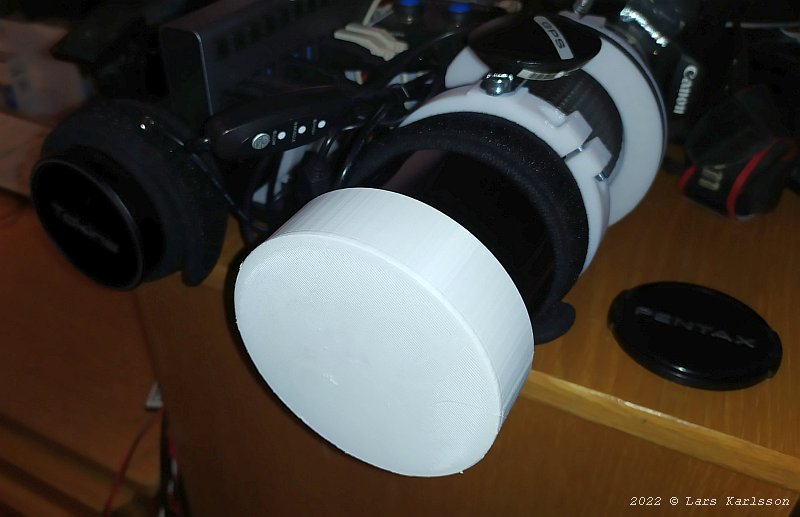|
Advertisement / Annons: |
Project:
|
Contents:
Related projects:
Note: |
1: OverviewI have been very pleased with my earlier medium format lens, a Pentax 6x7 165mm f/2.8. No vignetting to talk about even at f/2.8 but the color handling was far from perfect. Another medium format lens I have read about many years is the Pentax 645/67 300mm ED f/4, it use more advanced glasses of ED type and has a reputation to be very sharp, even at full opening. I have bought one now, a used Pentax 645, a smaller medium format compare to the earlier 6x7 I had. Now I have to take some test photos to see how good the quality is compared to my more modern designed Canon EOS 300 mm L f/4. The Canon lens is very sharp but have heavy vignetting problems, about half the signal is lost at the corners at full frame. This a short focal length lens, more a wide angle lens in the astro field. It's more suited to hunt nebulas with it. You can compare its 300 mm focal length to a 200 mm mounted on an APS-C format camera. This can collect more photons at the same aperture when using a full frame camera or even a medium format camera.
Update: Have a look at my vignetting test:Analyze of lens vignetting. 
This is how the Pentax 645 300 mm ED f/4 lens looks, almost exactly the same size as my Canon 300 mm L lens. It looks to be in good condition too. They are hard to find in Sweden, more common in Japan, due the huge import cost it's not interesting to import it. You find them at eBay among other places. There are lot of space where to place the two tube rings and a pulley for the focus motor. At rear the diameter is 75.5 mm and at the front 80.5 mm. Japan must have looked at my site, they are now sending a Pentax 300mm f/4 lens to space. I use an older variant in my project.

The mechanical focus stop looks to be far away from the true focus point for infinity, very good because then it's easier to handle it with a focus motor. The focus barrel rotates very smooth. Photos with my earlier Pentax 6x7 165 f/2.8 lens. 
I got both end caps included. The lens have 8 lens elements and of them are two of ED glass. Have a look at the internal construction:
I have designed a new front cover in 3D CAD that fits better. 
I didn't have any black filament at home, but this isn't that stupid. I tried to do sky flats with this front cover on and it work surprisingly well, gives more even flats than my complicated flat box. 
The lens surfaces looks clean and they are in good condition, no scratches. The filter diameter is 77 mm. 
The rear end of the lens with its bayonet. The back focus distance is 70.87 mm compare to Canon EF's 44 mm. Some extra room for filter wheels, off-axis adapter etc. Table of different lenses back focus:

To do some test with my Canon full frame camera I bought this adapter, Pentax 645 lens to Canon EOS camera. 
If I find that this lens is good for astrophoto I will later make a special adapter. A thinner adapter that let a filter wheel or something else be installed between the lens and the camera. I got a message from Greg in Australia, he sent me this link: Greg's photo 1 and this link: Greg's photo 2. Maybe enough to explain why I bought this old ens. Have a look also on the new Pentax 645 FA* ED 300 mm f/4 IF I recently bought. If one is good two is better, or ?
|
|